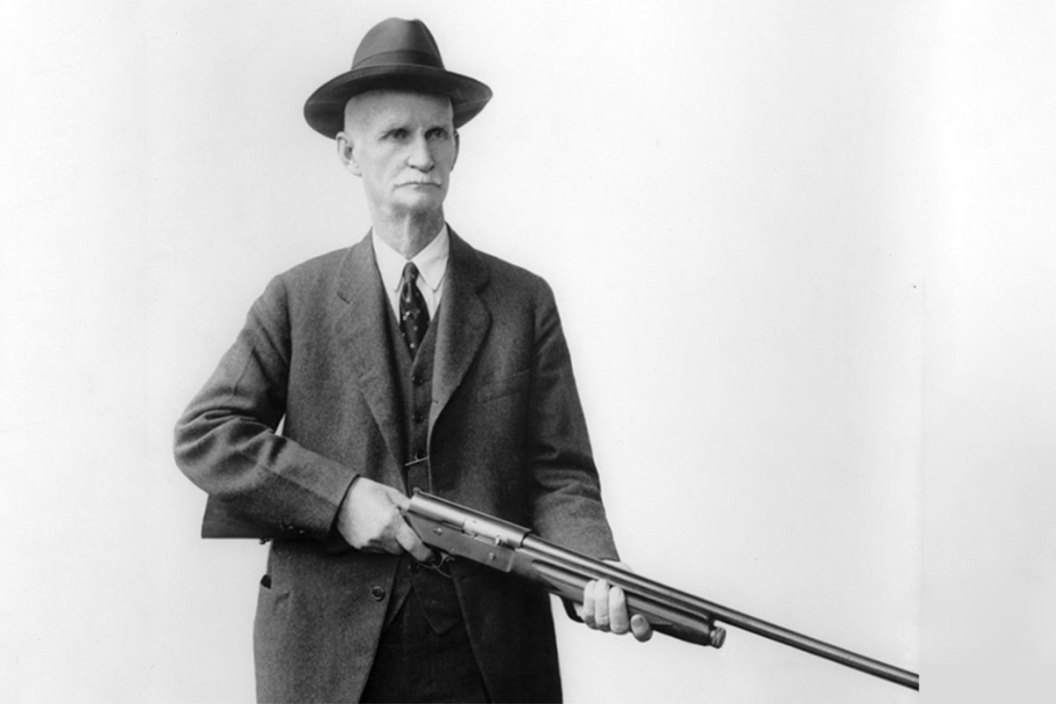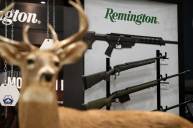Follow the life and carer of the most prolific gun designer of all time.
Samuel Colt may be the first name that comes to many people's mind when asked to name a famous American gunmaker and designer. But when it comes to who should rightfully earn the title of greatest gun designer of all time, it goes to John Moses Browning every time, no question.
No other person in history has been credited with so many revolutionary firearms designs. John Browning wasn't an inventor who dabbled in firearms, but a gun designer by trade.
He developed not only military and civilian firearms, but also numerous cartridges and many other firearm mechanisms in the 19th and 20th centuries.
Born Into It
John M. Browning's father, Jonathan Browning, was also an inventor who started his career as a blacksmith before plying his trade as a gunsmith, having apprenticed with Samuel Porter in Tennessee. The elder Browning invented a "sliding breech" repeating rifle in his Quincy, Illinois gun shop in the 1830s.
Even after becoming a member of The Church of Jesus Christ of Latter-Day Saints, Browning continued working on gun designs. The family moved to Nauvoo, Illinois after the followers of Joseph Smith were forced to leave Missouri.
After Joseph Smith was assassinated in 1884 in Carthage, Illinois, the Brownings left the state and followed Bringham Young to Iowa. When the family finally settled in Ogden, Utah, Jonathan ran a small gun shop. As was common among Mormons, Jonathan Browning was a polygamist with three wives and 22 children, one of whom was John Moses Browning, who learned his trade at that Ogden gun shop.
The younger Browning developed his first firearm when he was just 13, and was awarded the first of his 128 firearm patents by age 24, a rifle that Winchester would eventually manufacture as the Single Shot Model 1885.
Working With Winchester
Browning partnered with Winchester soon after he founded the Browning Arms Company with his brother, Matthew Sandefur Browning in 1878. Up to that point, he had developed designs for handguns and rifles, including lever-actions, pump actions, and semi-auto firearms.
Eventually, Browning's designs caught the eye of Thomas Gray Bennett, Vice President of the Winchester Repeating Arms Company at the time. Bennet purchased the manufacturing rights to one of Browning's single-shot rifle designs that used a falling block action.
After some tinkering by Winchester's engineers, the gun became the Single Shot Model 1885 and this first gun began along and fruitful partnership between Browning and Winchester. From 1885 to 1920, the gunmaker rolled out about 140,000 Model 1885s. Browning and Winchester would go on to make guns together for 20 years.
Winchester Model 1886
One of the most important guns to come out of the Browning/Winchester relationship was the Winchester Model 1886 lever action rifle, a repeater that featured a much stronger action than the 1876 Model, which could handle the new more powerful cartridges of the day.
The gun was originally chambered in .45-70, .45-90 WCF, and .40-82, and was later offered in several other big bore cartridges, including .50-110 Winchester. The action proved strong enough to make the jump to smokeless powder with only minor modifications to the rifle. Beginning in 1903, the model 1886 was chambered for the smokeless .33 WCF.
At the onset of World War I, the Royal Flying Corps bought Model 1886 rifles in .45-90 Sharps and loaded them with special incendiary bullets designed to ignite the hydrogen gas in German airships.
Winchester released a slightly modified version of the Model 1886 in 1935 as the Model 71 chambered for the powerful .348 Winchester.
Winchester Model 1892
In the early 1890s, Winchester was losing lever gun sales to Marlin and asked Browning to build a new lever gun as direct competition to Marlin's designs. The result was the Model 1892, which was a huge hit. Winchester sold over a million of them between 1892 and 1945.
The Great Depression killed sales of the 92 and production was halted at the onset of WWII when Winchester retooled for the war effort.
Winchester Model 1894
Browning continued to refine his lever action design, and later produced the Winchester Model 1894, which was one of the most famous and popular hunting rifles of all time.
The gun was made by Winchester through 1980, and then by U.S. Repeating Arms under the Winchester brand until 2006. Today, reproductions are made by Miroku in Japan and imported by Browning Arms.
Winchester Model 1887 Shotgun
Browning also created the most successful lever action shotgun of all time with the Winchester 1887, designed for lawmen and cowboys. Browning thought the shotgun should be a pump action firearm, but Winchester wanted to maintain its image as a lever gun company, so Browning gave them a breech-loading, rolling block lever gun.
A few years later he delivered what is regarded as the first successful pump-action shotgun ever with the Winchester Model 1893 and improved Model 1897, which was produced until 1957. The gun was succeeded by the hammerless Model 1912 pump gun, also designed by Browning.
The Auto-5 Semi-Automatic Shotgun
When Browning designed a semi-auto shotgun that would become the Browning Auto-5, he knew he had something special, and thought he should get a cut of the profits Winchester stood to make from it.
Winchester disagreed, so Browning went looking for new partner. He began producing the Auto-5 himself, and later sold licensing rights to several companies.
The shotgun was serially produced for over a century and was first manufactured by FN Herstal in Belgium beginning in 1902 as the Auto-5. It was also made under license by Remington as the Model 11 and by Savage as the Model 720—only the latter two variants lacked the magazine cutoff switch present on FN-made Auto-5 shotguns.
Browning A5 Shotguns, the modern version from the Browning Firearms Company, are still available.
Handguns of John M. Browning
While his long guns are legendary, John M. Browning's pistol designs are straight up iconic.
FN Browning M1900
One of the first handguns he designed was the FN Browning M1900. It was a single action, semi-automatic pistol that he designed for Fabrique Nationale de Herstal in the 1890s. It was chambered in .32 ACP with a seven-round magazine.
It was the first production handgun to feature a slide—a feature that is still predominant in semi-auto handgun designs today.
Colt Model 1902
Browning's next successful handgun design was made for Colt. The Colt Model 1902 pistol was a short-recoil semi-automatic that was basically an improved version of the M1900.
Two versions were produced, the Colt Model 1902 Military and Model 1902 Sporting. Only 7,000 of the Sporting models were made, and today, they are a sought-after item among collectors of both Colt and Browning-designed guns.
Colt M1903 Pocket Hammerless
The M1903 Hammerless pistol is arguably the first semi-auto handgun designed for concealed carry. Regardless of the name, the gun did have a hammer, which was hidden beneath the rear portion of the slide so as to keep it from snagging when carried in a pocket or under a jacket.
The gun proved popular with the United States Military and with Depression-era criminals of high renown. John Dillinger was carrying an M1903 Hammerless when he was gunned down by FBI agents in Chicago in 1934, and Bonnie Parker taped one to her thigh when she broke Clyde Barrow out of jail.
The M1903 was chambered in .32 ACP. A larger variant, the Colt Model 1908 Pocket Hammerless, was introduced in .380 ACP.
Machine Guns and the 1911
While Browning focused on sporting rifles and handguns meant for the civilian market for much of his career, he also design a plethora of firearms built for the battlefield, including the legendary Browning Hi-Power 9mm pistol and the M1911.
He also designed a number of machine guns that saw wide service in WWI, WWII and the Korean war, including the M1917 water-cooled machine gun, the M1919 air-cooled machine gun, the Browning Automatic Rifle (BAR), and the M2 .50 Caliber machine gun (aka the Ma Deuce).
Among the most famous of Browning's designs was the Colt M1911 .45 ACP pistol, which was used by the U.S. military from the 1911 until 1986 when it was finally replaced by the 9mm Beretta M9 pistol in 9mm.
It just so happened that the U.S. military was looking for an auto-loading pistol and a more powerful cartridge to replace the .38-caliber revolvers it was using, and Browning answered with the M1911 and the .45 ACP cartridge.
Browning's Colt 1910 won the military's pistol trials and evolved into the M1911, which was adopted by the U.S. Army on March 29, 1911. It was adopted by the U.S. Navy the same year and by the U.S. Marine Corps in 1913. It would go on to serve as the main sidearm for the U.S. military for the next 75 years.
Here is a complete list of all the firearms and cartridges designed by John Moses Browning:
Handguns
- FN Browning M1900
- Colt Model 1902
- Colt M1903 Pocket Hammer Model
- Colt M1903 Hammerless and M1908 Pocket Hammerless
- FN Model 1905 (1906) and Colt Model 1908 Vest Pocket
- FN Model 1910 and Model 1922
- Colt M1911
- Colt Woodsman
- Browning Hi-Power
Shotguns
- Savage Model 720
- Ithaca Model 37
- Stevens Model 52.620
- Winchester Model 1887
- Winchester Model 1893
- Winchester Model 1897
- Winchester Model 1912
- Browning Auto-5
- Browning Superposed
- Remington Model 17
Rifles
- Winchester Model 1885 Rifle
- Winchester Model 1886 Rifle
- Winchester Model 1890 Slide Action Rifle
- Winchester Model 1892
- Winchester Model 1894
- Winchester Model 1895 Rifle
- Winchester Single-Shot Rifle Model 1900 Rifle
- Winchester Model 1887 Lever Action Shotgun
- Winchester Model 1897 Pump Action Shotgun
- Winchester Model 1912 Shotgun
- Remington Model 17 and Ithaca Model 37 Shotgun
- Stevens Model 520
- Browning 22 Semi-Auto Rifle
- FN Trombone
- U.S. M1895
- U.S. M1917
- U.S. M1919
- U.S. M1918 Browning Automatic Rifle (BAR)
- U.S. M2 .50-Caliber
- U.S. M4 37mm
- .25 ACP
- .32 ACP
- .38 ACP
- .380 ACP
- .45 ACP
- .50 BMG
- 9mm Browning Long
Without a doubt, John M. Browning had a hand in the creation of so many influential firearms it'd be hard to say there was anyone who could rival his title as greatest gun designer ever.
He deserves that recognition if he doesn't have it already.
NEXT: THE 10 BEST BOLT-ACTION RIFLES EVER MADE
WATCH





